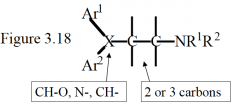![]()
![]()
![]()
Use LEFT and RIGHT arrow keys to navigate between flashcards;
Use UP and DOWN arrow keys to flip the card;
H to show hint;
A reads text to speech;
39 Cards in this Set
- Front
- Back
|
Rate theory |
Activation of receptors is proportional to thetotal number of encounters of a drug with itsreceptor per unit time. - does notrationalize why different types of compoundsexhibit the characteristics they do. |
|
|
occupancy theory |
Intensity of pharmacological effect is directlyproportional to number of receptors occupied - does not rationalize why different types of compounds exhibit the characteristics they do. |
|
|
modified occupancy theory |
(1) binding, or affinity, (2) initiation ofresponse, called either intrinsic activity (alpha) or efficacy |
|
|
Efficacy |
Efficacy is the property of a compound that producesmaximum response or ability to initiate a response |
|
|
efficacy is also known as |
intrinsic activity |
|

|
All are full agonists (sameefficacy; different affinities) |
|

|
5 different drugs (same affinitiesbut different efficacies) |
|
|
when alpha =1 |
full agonist |
|
|
when alpha is less than one |
partial agonist |
|
|
A full or partial agonist displays _______ efficacy |
positive efficacy |
|
|
An antagonist displays _____ efficacy |
zero efficacy |
|
|
A full or partial inverse agonist displays _____ efficacy. |
negative efficacy |
|
|
agonist, antagonist, partial agonist: which one induces a conformational change? |
agonist and partial agonist |
|
|
Activation -Aggregation theory |
Receptor is always in a state of dynamic equilibrium between activated form and inactive form |
|

which one is active and which one is inactive |
R- active T -inactive |
|
|
partial agonist bind to: R or T |
both |
|
|
agonist shift equilibrium to R or T? |
R |
|
|
antagonists shift equilibirum to R or T? |
T |
|
|
Two-state (Multi-state) Receptor Model |
have two states R and activated R* |
|
|
in the two state model where does agonist bind? |
R* |
|
|
in the two state model where does partial agonist bind? |
R* |
|
|
in the two state model where does antagonist bind? |
R and R* |
|
|
in the two state model where does full inverse agonist bind? |
only R |
|
|
all receptors are ______ and always _____ |
chiral and S |
|
|
racemic drugs have |
S or R form |
|
|
what is the pharmacophore for antihistamine |

|
|
|
the more potent enantiomer is called the |
eutomer |
|
|
the less potent enantiomer is called the |
distomer |
|
|
what is the eudismic ratio and when is it high |
Ratio of eutomer/distomer potencies of enantiomers High eudismic ratio when antagonist has chiral center inpharmacophore |
|
|
a distomer is really an |
impurity (isomeric ballast ) |
|
|
example of a distomer |
S thalinomide |
|
|
how many points of interaction does a receptor need to distinguish an enantionmer |
3 |
|
|
diasteromers |
non mirror images of one another, geometric isomers.. E and Z |
|
|
conformational isomers (conformers) |
differ by change in conformation |
|
|
conformationally rigid analogs allow you to do what and how |
To determine the active conformation, make conformationallyrigid analogs. The flexible lead molecule is locked into variousconformations by adding bonds to rigidify it. Pharmacophoricgroups are locked into various configurations; most potent isprototype for structural modification |
|
|
Atropisomerism occurs when there is |
hindered rotation about asingle bond as a result of steric or electronic constraints, causingslow interconversion of two conformers (a rule of thumb is a halflife> 1000 sec) |
|
|
considering 3D structures of rings... tranquilizers have what kind of angle |
aplha |
|
|
considering 3D structures of rings... alpha and beta give you |
mixed |
|
|
considering 3D structures of rings... alpha, beta, gamma give you |
antidepressants |

